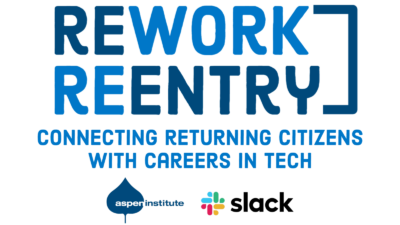The U.S. has the highest incarceration rate in the world, with more than two million currently in prison. Every week, around 10,000 of them are released, all too often with financial instability, difficulty securing housing, little to no familial support, and a conviction record that may bar them from receiving social services and meaningful employment.
A crime – often a mistake – sometimes committed in less than 30 seconds, can follow an individual long after they are physically released from prison. An estimated 70 million people—nearly one in three adults—have a prior arrest or conviction. Conviction records bar them from some of the benefits of citizenship; cultural and systemic bias bars them from societal re-assimilation. As a result, more than half of all released inmates relapse into criminal behavior, with many returning to prison within three years, according to the National Institute of Justice. A consequence of this cycle is mass incarceration has kept millions — returning citizens and their justice system-impacted families — in poverty, and communities of color are disproportionately impacted.
This estimation also indicates that millions more know someone or have a family member who is currently or formerly incarcerated. Communities, advocacy organizations, and local governments across the U.S. are working to bring public awareness to the experiences of returning citizens and drive effective solutions to counter negative lifelong impacts. Organizations such as the Last Mile and Criminal Justice at Code for America provide support during and after incarceration, aiding returning citizens with everything from business and technical training to the automatic clearing of records, where existing laws and expensive legal fees make sealing criminal records financially burdensome.
- The “Ban the Box” effort gives formerly incarcerated individuals a fair chance at employment by removing prior conviction and arrest history questions from applications, delaying background checks until later in the hiring process. Following the organizing work of All of Us or None, renditions of ban the box have been adopted in 37 states and over 150 cities and counties.
- The ‘HOPE for Prisoners’ partnership with the Las Vegas Metropolitan Police Department to build relationships between law enforcement and returning citizens.
- The Education Development Center’s From Prison Cells to PhDs, and other partners have launched STEM Opportunities in Prison Settings.
- Fair Chance Business Pledge is an Obama-era pledge companies could make to hire returning citizens. Signatories included Dropbox, Intel, Facebook, Google, etc.
- In late 2018, Congress passed bipartisan legislation to address recidivism known as the Formerly Incarcerated Reenter Society Transformed Safely Transitioning Every Person (FIRST STEP) Act. It increases re-entry opportunities for non-violent offenders by expanding rehabilitative programming and earned-time credit opportunities.
This combination of program and service provider organizations, advocacy organizations, and government action are strong steps in the right direction. But there’s room for a more substantial impact.
Access to employment is one of the most effective ways to address the inequitable experience of the returning citizen population. Statistics have shown that the technology industry has the most consistent demand and opportunity for career growth and stability. In January 2022, employers in the tech sector posted roughly 340,000 unfilled information-technology jobs. The number of openings varied across position types, and were 11% higher than the 12-month average, according to an analysis of the U.S. Bureau of Labor Statistics data by the IT industry trade group CompTIA.
Addressing the challenge of job access and fairness for returning citizens is a challenge, but not an impossible one. Even as awareness rises and advocacy organizations work to overcome employment hurdles, tech companies have a unique opportunity to make a meaningful difference in millions of lives by leveraging this motivated but disenfranchised population and fill these openings for technology roles.

Removing the /* STACKED CAPTCHA */
Returning citizens face a multitude of challenges when they depart the prison system. But true equity and access to technology roles begin prior to their release. Incarcerated people may lack the technical skills needed to apply to early-entry jobs in the tech sector, roles that often go to college interns and certified contractors, a code that individuals with criminal records are unable to crack on their own.
For more than a decade, the Last Mile has prepared formerly incarcerated people for tech roles by providing an education and technology training program while they’re still in the system, in addition to transitional support and workforce reentry training. The organization has built effective public-private partnerships that allow them to support returning citizens across six states, 16 facilities, and 23 classrooms.
Justice Through Code at Columbia University aims to equip participants with the requisite skills to embark on a sustainable career in the tech industry through a semester-long intensive training in coding, as well as interpersonal skills training and networking opportunities. The goal is for JTC students to emerge as competitive applicants for jobs, internships, or future job/tech training.
The TechEquity Collaborative focused on the employer, helping them overcome both perceived and actual challenges in hiring individuals with criminal records. Civic empowerment and community organizing, critical components of the Collaborative, brought tech companies and community-based organizations together to discuss the hiring challenges and the opportunities for both employers and the formerly incarcerated.
The result of this effort was the System Reset Implementation Guide, released in 2020. It illustrated how systemic racism affects the employment and incarceration of Black and brown people. Despite their best efforts to “build a tech company ecosystem that views returning people as any other candidate or employee across a variety of roles and job types,” reception and perception by the members of the tech industry limited the guide’s overall impact.
The lack of implementation of the TechEquity Collaborative’s recommendations across the industry revealed challenges at various levels — and to varying degrees — of both large and small-scale tech companies. It underscores the importance of crafting a solution that focuses on the needs of each organization, its current staff, and its formerly incarcerated employee force.

<href=Leadership in the Workspace>
Leaders of for-profit and private organizations play a consequential role in breaking this cycle of recidivism and unrealized employment. Slack in particular has been a pioneer, launching in 2018 Next Chapter, originally as a six-month apprenticeship program for returning citizens, and then expanding to a full-time employment initiative. This shift has had a lasting impact—on Slack’s internal culture, on the larger business industry with whom they contract, and on the population of formerly incarcerated individuals seeking skilled long-term employment.
Slack recently announced a new milestone in their effort in this complex racial justice space: 14 tech companies have joined Next Chapter, a four-year-old program that’s accelerating the systemic and cultural shifts needed for returning citizens to secure sustainable employment in the tech industry.
Next Chapter partners have made it clear that their motivation is a thoughtful, long-term systematic shift in culture. The partner organizations and those employees who guide this process work are actively dismantling their own racial and cultural biases. This is a human challenge that requires an empathetic and sincere approach.
This can be a difficult, time-consuming change. Companies have stumbled by using overly restrictive data practices, not properly training managers on the extra needs of returning citizens and their justice-impacted families, or not sufficiently building staff support before the hiring process begins.
Every level of the company has a role to play to ensure equity and inclusion, accountability, and transparency when incorporating individuals with criminal records into their workforce. Smaller companies have more flexibility to adjust their practices. In larger companies, where teams are more siloed, C-Suite executives will need to do more to ensure buy-in. Change that starts on the ground level also needs support from the top.
Thoughtful preparation and a genuine understanding of this work will have resounding impacts on both the returning citizen and the people they work with. Choosing to hire and support people who are formerly incarcerated can send a strong signal to all employees that the company is willing to invest in people who are systemically framed as difficult to hire, train, and retain, and can better reflect the moral values and principles of its culture.
Ctrl + F [“reasons why”]
Lowering the rate of recidivism and removing the barriers to job opportunities, career growth, and wealth equity requires a whole-of-society approach. States’ legislative actions, TechEquity Collaborative’s policy recommendations, and Nevada’s law enforcement prison partnership are deleting the lines of code that have predetermined millions of Americans’ ability to secure and maintain a stable lifestyle.
Silicon Valley and tech companies across the nation are well-positioned to lead the way toward long-lasting systemic change on a scale that can effectively address this uniquely American crisis.


